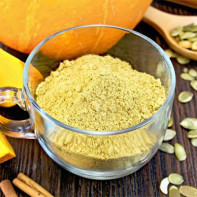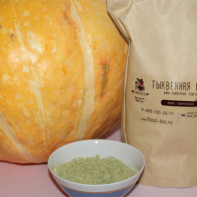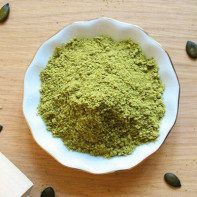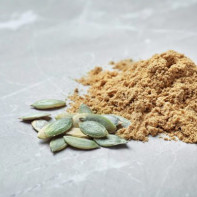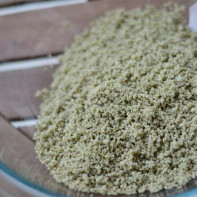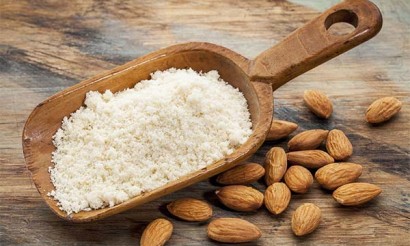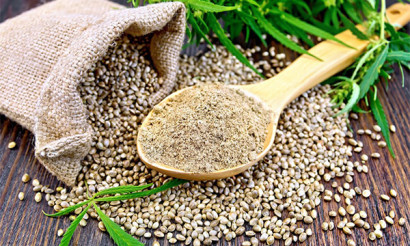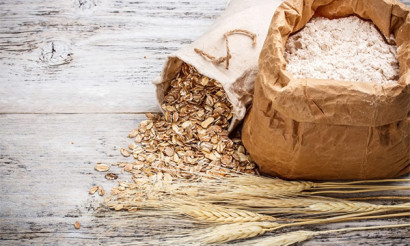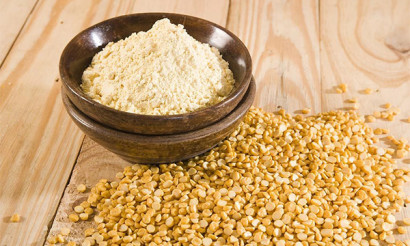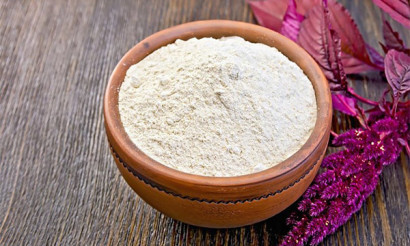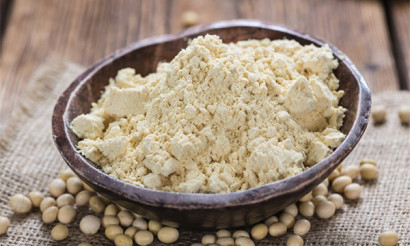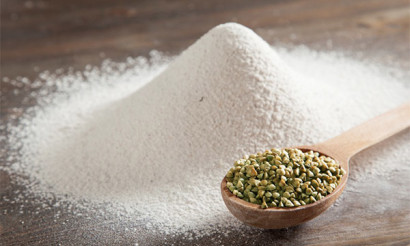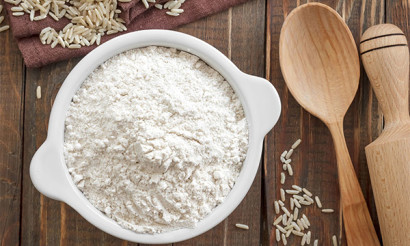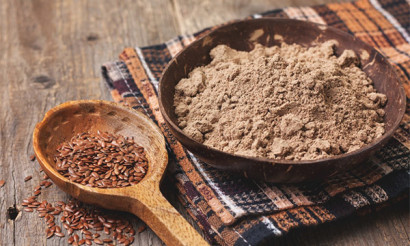Pumpkin seed flour: useful properties and contraindications
Pumpkin seeds are one of the most useful products. They have many medicinal properties. But the scope of their application for a long time was limited to the fact that they were either eaten raw or dried, or made into oil. In recent years, another product of their processing, which has all the useful properties of seeds, has appeared - pumpkin seed flour. Today it is increasingly used in cooking and cosmetology.
- Which is healthier: pumpkin or wheat flour
- Composition and calories
- What is Pumpkin Flour Good for?
- General benefits
- For Women
- For Men
- For Pregnancy
- Breastfeeding
- For children
- For weight loss
- How to Use Pumpkin Flour for Therapeutic Purposes
- Cosmetic use
- Harm and Contraindications
- How to Store Pumpkin Flour
- How to Make Pumpkin Flour at Home
- From the seeds
- From the pulp
- What can be made of pumpkin flour: Recipes
- Pumpkin and cottage cheese casserole
- Pumpkin flour cookies
- Traditional Cake
- Interesting facts about pumpkin
What is healthier: pumpkin or wheat flour
There is no definite answer to this question. On the one hand, wheat flour has a higher caloric value - 342 kcal per 100 g, while pumpkin flour has about 305 kcal. At the same time, wheat flour contains more proteins and has a higher nutritional value.
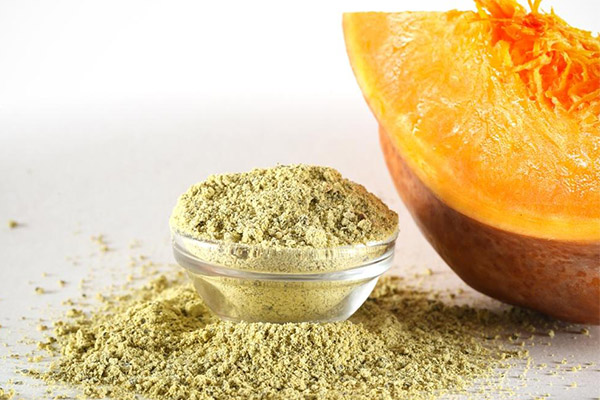
On the other hand, wheat flour contains the protein gluten, which can cause such a disease as celiac disease. Pumpkin flour is gluten-free, so it is suitable for people suffering from this disease. At the same time, it contains many micronutrients. Often nutritionists advise to mix both types of flour to get the maximum benefits.
Composition and calories
The energy value of pumpkin flour is quite high - about 305 kcal per 100 g. But the unique chemical composition makes it incredibly useful.
Pumpkin flour contains the following components:
- Ascorbic acid, which increases immunity.
- Carotenoids, which are beneficial for eyesight.
- B vitamins, including folic acid.
- Valuable omega-3 fatty acids, essential for normal body function.
- Rich in minerals, including phosphorus, selenium and zinc (and it is considered a champion in zinc content, as only sesame seed contains more of this element).
It should also be noted that 60 grams of pumpkin meal contains phosphorus and magnesium in an amount sufficient to meet the daily requirement of an adult.
Pumpkin flour contains many flavonoids and several dozen amino acids, thanks to which it is considered a valuable dietary product.
What is pumpkin seed flour good for?
General benefits
Pumpkin flour contains many beneficial substances, thanks to which it can be used
- To normalize digestion;
- strengthen the natural immune system;
- improve cardiovascular function;
- treatment of helminth infections;
- Weight loss and prevention of diabetes.
Also pumpkin meal helps significantly improve the condition of the skin, hair and nails due to the high content of vitamins and zinc.
For women
For women, pumpkin meal is, above all, a beauty product, because it helps to cope with problematic skin and promotes the rejuvenation of the body. But this product is also important for normalizing the hormonal background. It is especially useful during menopause, as it allows you to avoid the complications and unpleasant symptoms associated with it, to prevent the deterioration of cardiovascular activity associated with this period.
For men
For members of the stronger sex, this product is interesting because it contains a lot of zinc. This allows you to get rid of inflammatory diseases of the prostate gland and in general has a good effect on erectile function and the condition of the organs of the reproductive system.
In pregnancy.
For future mothers, this product is important because it allows them to prevent various forms of anemia - a problem faced by many pregnant women, since most vitamins and minerals are consumed by the body for the development of the fetus. At the same time, pumpkin meal allows you to get rid of swelling and helps to regulate weight, which is also very important in pregnancy.
When breastfeeding
There are studies that prove that the substances contained in pumpkin meal can improve the psycho-emotional state. It is important for young mothers in that it helps prevent postpartum depression. Also consuming pumpkin flour will help to get rid of extra pounds gained during pregnancy, as well as to fix the skin and hair.
For children
For children, pumpkin flour is useful because it contains many vitamins necessary for the normal development of the body. In addition, it does not contain gluten, and many modern children suffer if not from intolerance, then from an excessive sensitivity to this protein. Pumpkin seed flour can be introduced into the diet of children after a year, adding it little by little to porridge.
When losing weight
Pumpkin meal itself is not a fat-burning product. But it helps to adjust the metabolism, which leads to a decrease in fat deposits. In addition, with its help you can normalize digestive processes, which will get rid of toxins.
Some nutritionists advise following a three-week diet in which one meal is replaced with a smoothie based on fermented dairy products and pumpkin flour. The rest of the meals should simply follow the rules of healthy eating, that is, you will need to give up fried and fatty foods, alcohol, sweet sodas and buns.
The scheme of taking the cocktail will be as follows:
- During the first week, for breakfast, you need to drink half a glass of cocktail based on 100 ml of nonfat yogurt or kefir, mixed with 1.5 tsp of pumpkin flour.
- During the second week breakfast will be more nutritious - already 3 tsp. pumpkin flour per 100 ml of nonfat kefir or yogurt.
- During the third week the volume of the morning portion increases - it is already 4 tsp. spoonfuls of flour per 150 ml of kefir or yogurt.
During this time you can lose 5-7 pounds of extra weight. It may seem that this is not too impressive result. But it will be stable, the extra weight will not return for a long time, especially if you periodically drink such a cocktail to cleanse the body. In addition, weight loss occurs in the safest possible way for the body.
How to take pumpkin meal for medicinal purposes
The unique composition of pumpkin meal makes it an excellent therapeutic agent. It is rarely used as an independent medicine, but it is an important part of the complex therapy. Among its advantages, among other things, include the fact that it can be combined with any dish without losing its beneficial properties. In addition, it can be taken in combination with any medications. Sometimes it is prescribed as a preventive measure when you need to take a lot of different medicines. In such cases, pumpkin meal helps to relieve the liver and acts as a hepatoprotector.
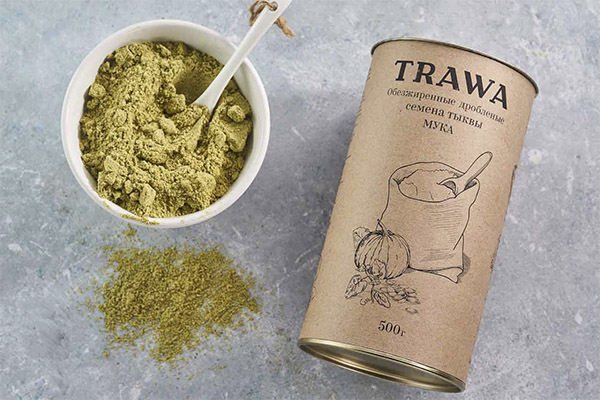
It is very difficult to eat a spoonful of pumpkin meal just like that, dry food. Therefore, it is recommended to add it to fermented dairy products in an amount of 1-2 tsp. spoon per 100 ml of kefir or yogurt. Such a remedy can be taken no more than twice a day. The duration of the course of treatment is one month, after that it is recommended to take a break. A total of 3-4 such courses can be taken during the year.
Cosmetic applications
Pumpkin meal, obtained from the pulp of this fruit, is recommended to use in home cosmetology. It contains B vitamins, ascorbic acid, as well as zinc, which has anti-inflammatory properties, which makes this product incredibly useful in the fight against acne. At the same time, pumpkin meal contains components such as methionine and lysine. These are amino acids that stimulate the production of collagen, the protein responsible for youth and elasticity of the skin. Therefore, remedies based on pumpkin flour have a rejuvenating effect.
For example, you can prepare the following masks:
- For dry skin. You need to take 2 tablespoons of pumpkin seed flour, mix it with 1 tablespoon of kefir or sour cream, the same amount of flower honey and lemon juice. Apply the mixture to cleansed skin for 15 minutes, then rinse thoroughly. The composition has a light whitening effect. It also has a wound-healing effect, so sometimes it is applied only to the affected areas.
- Mask against pigmentation. Pumpkin meal is mixed with hot water so that the product has a very fluid consistency (like cosmetic milk). Add pumpkin juice or freshly squeezed lemon juice and rub the pigmentation areas instead of lotion.
- Rejuvenating mask. It is necessary to boil about 20 grams of flour in a small amount of boiling water so that there are no lumps, and then hold over low heat until it thickens, then turn off and wait until it cools. Meanwhile, rub the skin with a mixture of olive oil and lemon juice, then apply the pumpkin mask and wash it off after 15 minutes with warm water.
Similarly, pumpkin seed flour is used to care for the skin of the hands and cuticles. You can combine it with various oils.
Also pumpkin flour is added to ready-made masks for hair in order to relieve inflammation from the scalp and get rid of seborrhea.
Harms and Contraindications
Although in general pumpkin meal is useful and does not cause allergies, you can not exclude its individual intolerance. When including this product in the diet, it is always worth a couple of days to observe the reaction of the body, before proceeding to regular use.
It is not recommended to take more than 4-5 spoonfuls of pumpkin meal a day, because it can provoke digestive disorders, diarrhea or constipation, depending on the inclination of the body. In irritable bowel syndrome, such amount of fiber can cause flatulence.
How to Store Pumpkin Flour
Store this product in the same way as any other flour, that is, provide protection from humidity and direct sunlight. If the flour will stand where it will be constantly exposed to sunlight, it will change its smell, it will become slightly rancid. Its taste qualities in this case will also deteriorate.
The best option is to store flour in a dark and dry place at room temperature. Many manufacturers produce it in an airtight package with a special lock. If the flour is consumed quickly, you can leave it in this package. Otherwise, it is better to pour it into a glass jar, the lid of which is tightly closed.
How to make pumpkin meal at home
Pumpkin flour is offered by retailers specializing in organic products. With all the positive qualities of such flour, it has a serious disadvantage - a high cost. But it is possible to prepare such a product and at home. This is especially relevant for those people who grow pumpkin themselves, because in such cases they can be fully confident in the quality of the original raw material.
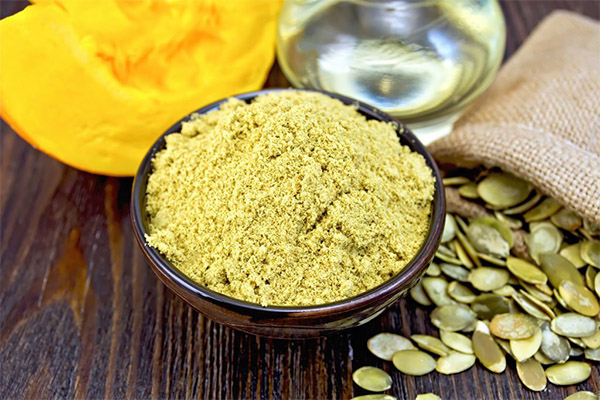
From seeds
As already noted, pumpkin flour is most often prepared from the seeds. But not every pumpkin can be used to produce seeds that are suitable for flour production. Practice shows that the best results are given by large-fruited varieties. In this case, preference should be given to hard-skinned varieties. Some countries have even bred special holosemic pumpkins, also called holo-grain pumpkins. For example, these are such varieties as Hercules or Golosemnaya 14 (selection of Gribovskaya station). In these varieties, the seeds have almost no peel, and are covered only with a thin film, which facilitates their processing and allows you to get flour with improved properties. It can easily be used for baking bread, muffins or pancakes.
But, if such varieties of pumpkin are not available, you can be limited to ordinary ones. Only you need to understand that the yield of flour will be small, since the seeds in the fruit do not contain so many. For example, if the weight of the vegetable is 3-4 kg, then on average about 100 grams of flour will be obtained from its seeds. So it can be considered a premium product in any case.
So, to obtain the flour, the fruit is thoroughly washed, then wiped with a cloth. The peeling stage is very important, since the seeds are not heat-treated.
Then the pumpkin is cut, the seeds are selected, trying to clean them immediately from the sticking pulp. After that, they are spread out in a single layer on clean paper (never on newspaper), and then dried naturally. If there are pets or small children at home, it is better to place the seeds on a shelf that cannot be reached.
Peeling the seeds from the peel is not recommended. The fact is that under the peel there is a green film, and it contains the substance cucurbitacin, which, as studies show, helps to fight even malignant tumors.
In the next step, the dried seeds are ground in a coffee grinder or a special grain mill. Each time a portion is put into the device so that the knife can move freely. During the primary processing, the knife will crush the seeds, separating them into large pieces. In this case, the seed itself is destroyed faster than the shell. In all the following stages, the rind will also be crushed, but still by the time the seed is turned into powder, its particles will be coarser than the rest of the flour. So at the final stage, the obtained product is necessarily sifted to get rid of bran.
From pulp.
You can also make flour from dried pumpkin pulp. Although this is more likely just a vitamin powder, because it will not contain so much protein and fatty acids. But it will contain more carotenoids, and they have a pronounced antioxidant effect. Although this flour will not be suitable for baking, it can also be added to smoothies, smoothies, sauces, soups and vegetable stews for dietary and therapeutic purposes.
To prepare this flour, be sure to take a ripe pumpkin, check it so that it has not been spoiled. Then it is thoroughly washed, peeled and the seeds are removed. The pulp is ground on a coarse grater, but you can also cut it into small cubes. Then it is dried either in an oven or in a household dryer, since it would take too long to dry naturally. The dried mass is ground in a blender or mill to a powder, which will have a beautiful yellow or orange hue.
What can be made from pumpkin flour: recipes
Although this product appeared in mass quantities relatively recently, cooks have learned to use pumpkin flour in a variety of dishes. Unlike wheat, it has a characteristic pleasant flavor. And pastries made from it are considered more lush and fragrant. However, pumpkin flour is used not only for baked goods, but also as a thickener in the preparation of soups and sauces. It can be combined with a variety of ingredients. For example, for baking, pumpkin flour is often mixed with wheat, rye, or oatmeal. It is also combined with linseed or sesame seeds, kernels of nuts, etc.
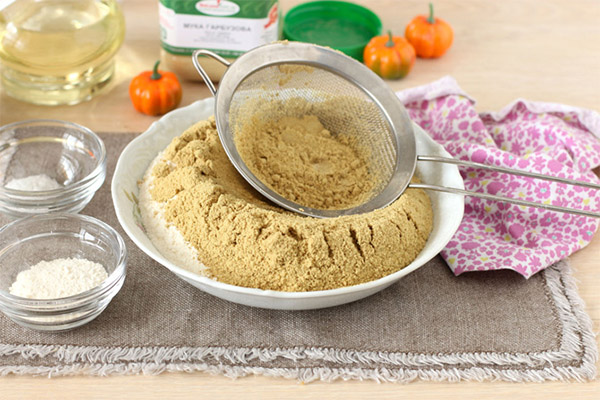
You can try the following recipes.
Pumpkin and cottage cheese casserole
For its preparation, 500 g of low-fat cottage cheese requires a glass of pumpkin flour (200 g), raisins or other dried fruits, sugar to taste, 2-3 chicken eggs (you can take more, if they are small).
First, the cottage cheese is rubbed with flour and sugar until a homogeneous mass is obtained, then raisins or chopped dried fruits are added and thoroughly mixed. The eggs are beaten separately, then the resulting mass is poured in, again mixed. If desired, you can add a little vanilla or cinnamon to this batter. The baking dish is greased with oil or lined with parchment paper. It is recommended to use corn or linseed oil, preferably unrefined, so that the casserole will be more fragrant. The dough is distributed in the form and smeared with whipped egg yolk or sour cream. Bake in the oven at 250 degrees. The mass is dense, but bakes in about 15-20 minutes.
Pumpkin flour cookies
To bake better retain the shape, it is recommended to mix pumpkin flour with wheat flour in the ratio of 1:2. The cookies still retain their healthy properties, but will contain fewer glutens than the usual ones. At the same time, it turns out quite beautiful and puffy, preserving its freshness for several days.
For a glass of pumpkin and wheat flour mixture, 100 g of butter, as well as 5 tablespoons of sugar are needed. The butter is heated until it becomes liquid, then the sugar is added and stirred properly until it dissolves, and then mixed with the flour. If necessary, the dough can be made less dense by adding milk to it. To make the cookies puffy, use either baking powder or baking soda. To give it a nice flavor, lemon zest is added. Roll out the dough with a rolling pin and cut out the cookies with shaped shapes. The resulting figures are baked on a baking tray (on parchment or on a greased surface).
Traditional cake
For this dish you will need only pumpkin flour - 0.5 kg for 1 cup of sugar and 5 eggs. To make the muffin more fragrant, use a little rum or fragrance essence. For fluffiness you will need baking powder or baking soda.
The egg whites are beaten with a cup of sugar until a thick froth appears. The yolks are beaten with a few spoonfuls of sugar, vanilla and cinnamon. Meanwhile, sift the flour to make it fluffier (and the dough lighter), add the baking powder, then pour the yolks whipped with sugar, rum and mix. When the mass is ready, whipped whites are poured in. But this time it is not necessary to stir thoroughly. Such an unevenly poured mass of whites is distributed over the form and put in an oven heated to 80 degrees. Bake the muffin at this temperature for 20 minutes, then check its condition. A golden hue is a characteristic sign of the finished dish. When the cupcake cools, it is covered with coconut or chocolate frosting.
Of course, baking with pumpkin flour can be called dietary only conditionally, because it still contains sugar, so you need to observe moderation in its consumption.
Pumpkin flour itself is often used to reduce the caloric content of traditional dishes. For example, minced meat products are breaded in it. Flour from pumpkin pulp can be poured into whole-grain porridge when cooking - you get a vitamin additive that will give a dish a beautiful shade.
Interesting facts about pumpkin
The fact that the pumpkin has medicinal properties has been known since ancient times. This is evidenced both by archaeological findings and by the mention of the pumpkin in many ancient myths of Egypt and the peoples of Eurasia. In the Middle Ages Europeans did not yet know sunflower oil - the sunflower was brought much later from the New World. But they knew how to extract oil from pumpkin seeds, which was often called black gold because of its color, cost and useful properties. That was also when they began to process the remainder of the grains, formed after the pressing, into flour.
Already in the Renaissance, when new trade routes to Asia opened up, the pumpkin made its way to the Far East - China, Japan, and India. This is where most pumpkins are now grown for seed. And pumpkin meal is one of the most popular nutritional supplements in this very region.
«Important: All information on this site is provided for informational purposes only purposes. Before applying any recommendations, consult a health care professional. specialist. Neither the editors nor the authors shall be liable for any possible harm caused by materials."

